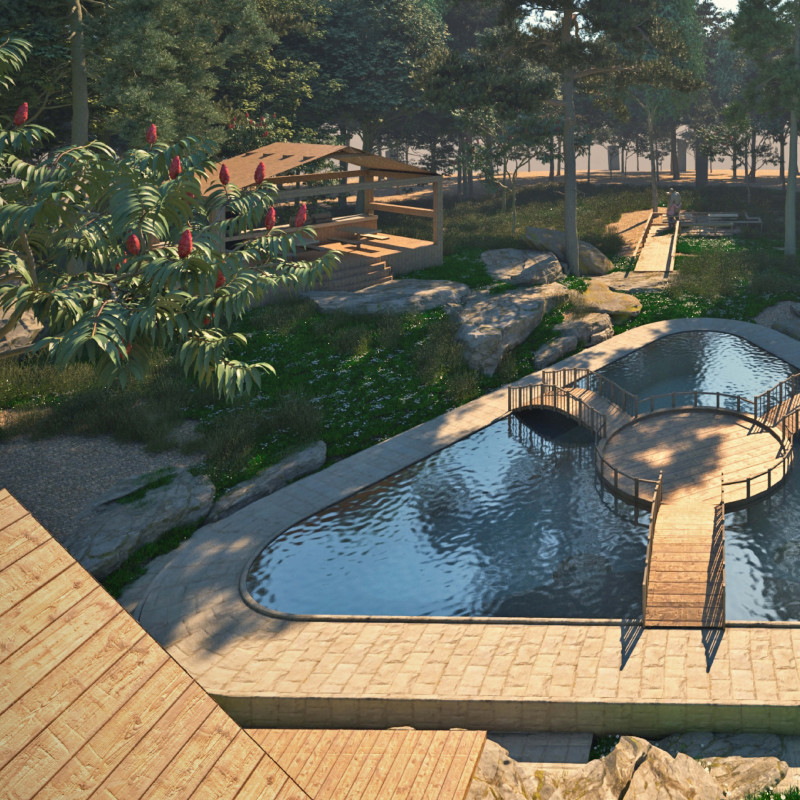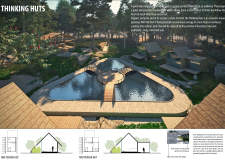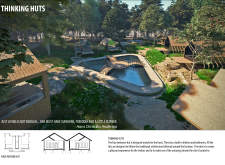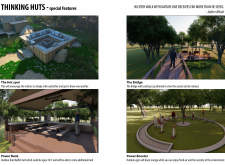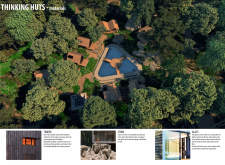5 key facts about this project
Architecture within the Thinking Huts project embodies a philosophy grounded in simplicity and elegance. Each hut is positioned to blend harmoniously with the surrounding landscape, promoting a seamless bond between the built environment and nature. This connection not only enhances the aesthetic appeal but also enriches the experience of solitude, as inhabitants are meant to feel that they are integrated into the natural world around them.
The primary function of the huts revolves around providing a tranquil space for reflection and creativity. Every component of the design has been considered, from the spacious interiors that allow for free movement and light to the carefully curated outdoor areas that invite visitors to explore and connect with nature. The layout is particularly unique, with smaller personal spaces and larger communal areas designed to strike a balance between privacy and social engagement. This duality ensures that whether an individual desires solitude or company, their needs can be met.
In discussing the important parts of the design, the central water feature stands out as a significant element, acting as both a visual focal point and a contributor to the site's ecological health. The interaction of water with the surrounding flora creates a soothing atmosphere, enhancing the sensory experience for occupants. The addition of a communal area known as the Hot Spot encourages socialization, inviting guests to gather, share ideas, and foster community interactions while enjoying the surrounding beauty.
Materiality plays a central role in the Thinking Huts project’s architectural expression. Timber, stone, and glass are the primary materials utilized, each selected for their properties and aesthetic contribution. The use of timber not only ensures sustainability but also aligns with the natural surroundings, providing warmth and a tactile quality to the huts. Stone adds durability and grounding to the overall structure, while glass facilitates the flow of light and integrates the interior spaces with outdoor vistas. This choice of materials reflects a modern sensibility towards environmental responsibility while embracing local building traditions.
The design approach of Thinking Huts is characterized by its innovative integration of natural and architectural elements. The strategic placement of the huts maximizes views and minimizes disturbance to the environment, allowing inhabitants to experience nature from within their living spaces. The architecture is intentionally minimalist, reducing visual clutter and allowing the beauty of the surroundings to take precedence. This focus on simplicity not only enhances the visual appeal but also fosters a sense of clarity and calmness conducive to creative work.
To truly appreciate the nuances of the Thinking Huts project, interested individuals are encouraged to explore the architectural plans, architectural sections, and overall architectural designs. A deeper understanding of the architectural ideas and the thoughtful considerations behind each element can shed light on how these huts function as both personal retreats and communal spaces. By engaging with the details of the design, viewers can gain insights into how the project embodies its mission to create an inspiring environment for creative individuals. The Thinking Huts project stands as a testament to the potential of architecture to provide not just shelter, but meaningful spaces that facilitate personal growth and connection to nature.


